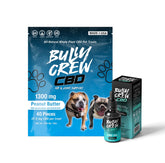As dogs age, they can develop a variety of lumps, bumps, lipomas, and cysts. While these growths can be concerning, they are not always harmful. One common type of benign cyst is a sebaceous adenoma in dogs. These harmless growths can appear more frequently in older dogs.
However, it is important to recognize that lumps can range from benign (harmless) to malignant (harmful), and many have names ending in oma, such as lipomas, adenomas, or histiocytomas. Each type of lump has its prognosis and requires different actions. Knowing the characteristics and implications of these growths can help you manage your dog's health more effectively. Understanding what to look for and when to consult a veterinarian can ensure your dog receives the best care.
What is sebaceous adenoma in dogs, and What Causes Adenomas?

A sebaceous adenoma is a common bump that can appear on your dog's skin. These bumps originate from the sebaceous glands, which secrete sebum, an oily substance that keeps the skin lubricated. When these glands overproduce oil, they can swell up and form a non-cancerous tumor-like growth filled with sebum, resembling a harder, permanent pimple. Preventing sebaceous adenomas in dogs remains unclear, but they are generally not harmful.
This sebaceous gland tumor in dogs usually appears flesh-colored, hairless, and slightly ridged, similar to a wart or cauliflower. They are often found on the head, neck, eyelids, and extremities and typically stay between ¼" and ½" in size. Since they are non-viral, your dog's immune system does not influence them. However, if you notice any changes in the color or size or if the adenoma becomes ulcerated (opens and becomes bloody or raw), you must consult your veterinarian. In rare cases, sebaceous adenomas on dog can develop into a more harmful growth known as sebaceous adenocarcinoma.
sebaceous adenoma Causes:
Changes in your dog's hormones or chemicals can lead to skin problems like infection, inflammation, clogged pores, and infected hair follicles. Oil, injuries, dirt, or infections can cause these clogs. As dogs age, their skin can become drier or oilier due to hormonal changes. While this can sometimes lead to cancerous growths, it more often results in common dog warts or sebaceous adenomas. A sebaceous adenoma in dogs occurs when the skin produces too much sebum to combat dryness, leading to blocked hair follicles.
Causes of pH Imbalance in Dogs
A dog's skin should have a pH balance of around 7.5 on a scale from 0 to 14, with numbers below 7 being acidic and above 7 being alkaline. Several factors can disrupt this balance:
- Excess sebum production due to dry skin
- Genetics and age
- Detergents and cleansers
- Frequent bathing
- Use of antibacterial products that harm the skin's microbiome
- Certain skin conditions and allergies
- Poor-quality diet, including high salt, protein, dairy, carbohydrates, and sugar
Additionally, metabolic diseases like diabetes or renal failure, the use of corticosteroids and NSAIDs, poisoning, urinary blockages, sustained vomiting, and excessive doses of diuretics can also cause pH imbalances.
Diagnosing Sebaceous Adenoma on dog
If your dog has a lump, it's important to visit your veterinarian to find out what it is. The vet will review your dog's medical history, perform an exam, measure the lump, and may take a sample using a fine needle aspiration or a biopsy. Fine needle aspiration involves taking a small, painless sample of the lump with a tiny needle, without needing sedation, to examine the cells under a microscope. If the vet suspects something more serious, they might take a larger sample (biopsy) and send it to a lab for further analysis.
Conventional Treatment Options for Dog Sebaceous Adenomas
The need to remove sebaceous tumors in dogs varies by breed. These growths are usually harmless and don't grow, so surgery is often unnecessary. Even if removed, they may return because they result from a gland malfunction, meaning the issue can recur.
Sebaceous adenomas are common in all dogs, especially as they get older. Certain breeds are particularly prone to developing these growths like:
- Cocker spaniels
- Huskies
- Malamutes
- Samoyeds
- Certain terriers
- Poodles
- Shih-tzus
- Basset hounds
- Beagles
If your dog has a growth that is itching and causing them to chew or scratch at it, leading to ulceration or scabbing, you may need to have it removed. Similarly, if your dog is a breed that requires professional grooming, and the growth is in an area prone to being cut or shaved, surgery might be necessary. Growths on the eyelids or mouth might also require surgical removal. Otherwise, you can leave the growth alone and regularly monitor its size, shape, and color.
Full Spectrum Hemp CBD for Dog Sebaceous Adenoma
A non-invasive, natural option for treating tumors in dogs that many veterinarians might not be aware of is the use of a full-spectrum hemp extract salve infused with essential oils like peppermint and eucalyptus, known for their tumor-killing properties.
These salves contain ingredients that help the immune system identify and eliminate abnormal cells. The main ingredient, Full-Spectrum Hemp Extract, has proven anti-neoplastic properties and can combat abnormal growths. Full-spectrum hemp Extract and its components can influence multiple cancer-related pathways.
Cannabinoids in Full Spectrum Hemp Extract can block cell growth, interrupt the cell cycle, and selectively induce apoptosis (cell death) in tumor cells. Since the skin has double the CBD receptors, using Full Spectrum Hemp Extract topically is highly effective against neoplastic growths. When used alongside an orally administered Full Spectrum Hemp Extract, you get a powerful combination working internally and externally to eliminate abnormal and cancerous cells throughout the body, including sebaceous adenomas in dogs.
Conclusion
Dog sebaceous adenoma is generally a benign growth that can't be prevented. Depending on the dog and its location, it may need to be surgically removed. However, surgery is often a constant challenge, as the growth can return. Using full-spectrum hemp extract salve and Full Spectrum Hemp Extract CBD oil together can achieve excellent results without the need for surgery in dogs with sebaceous adenomas.







